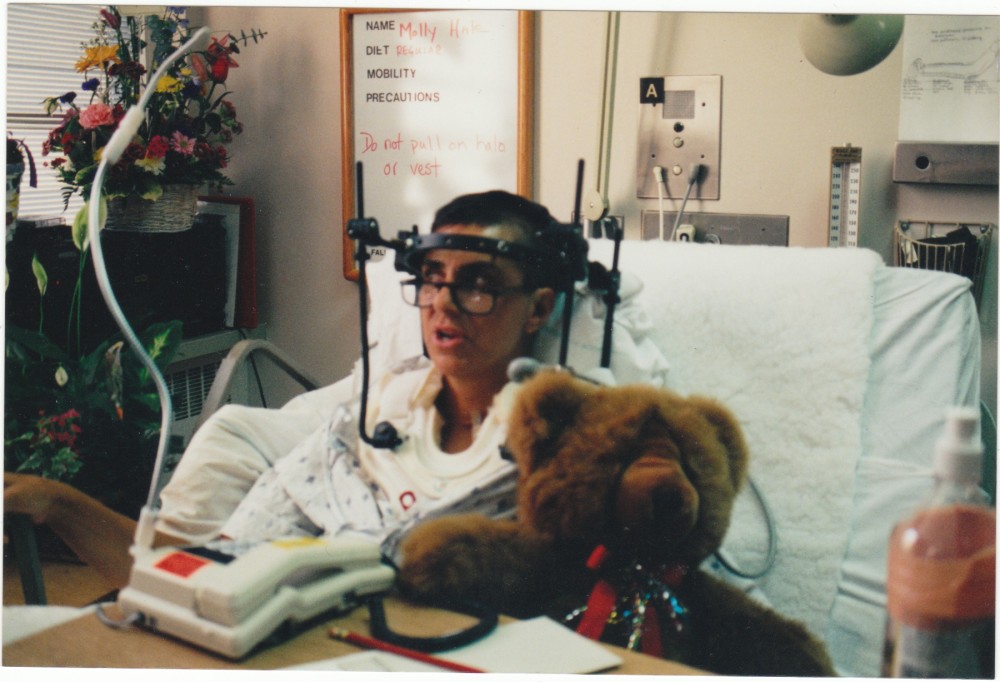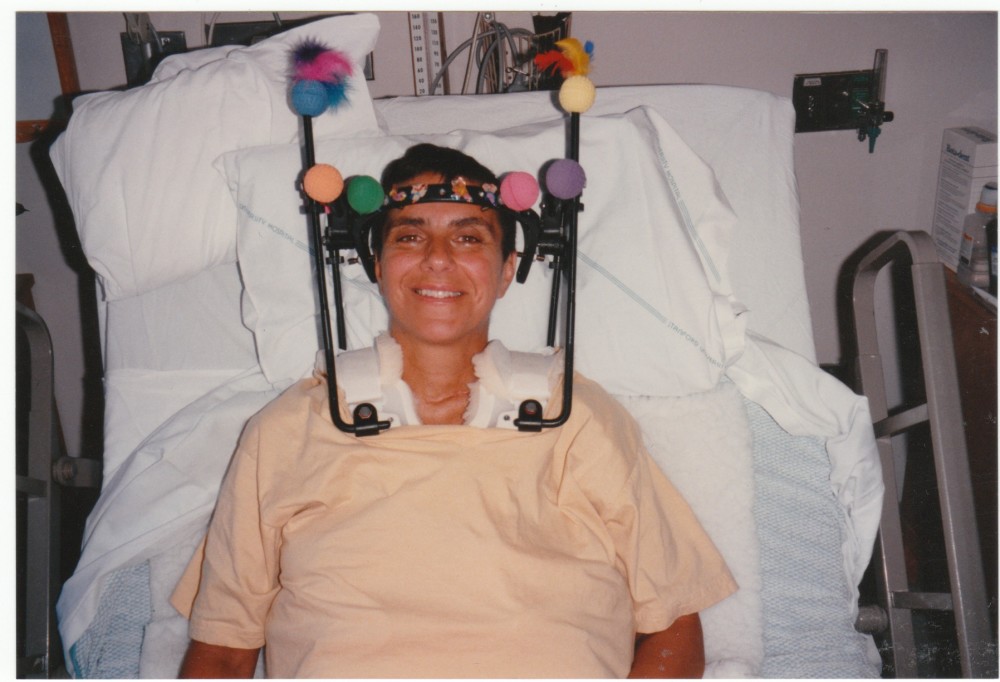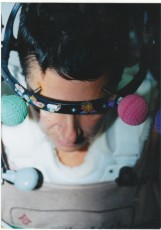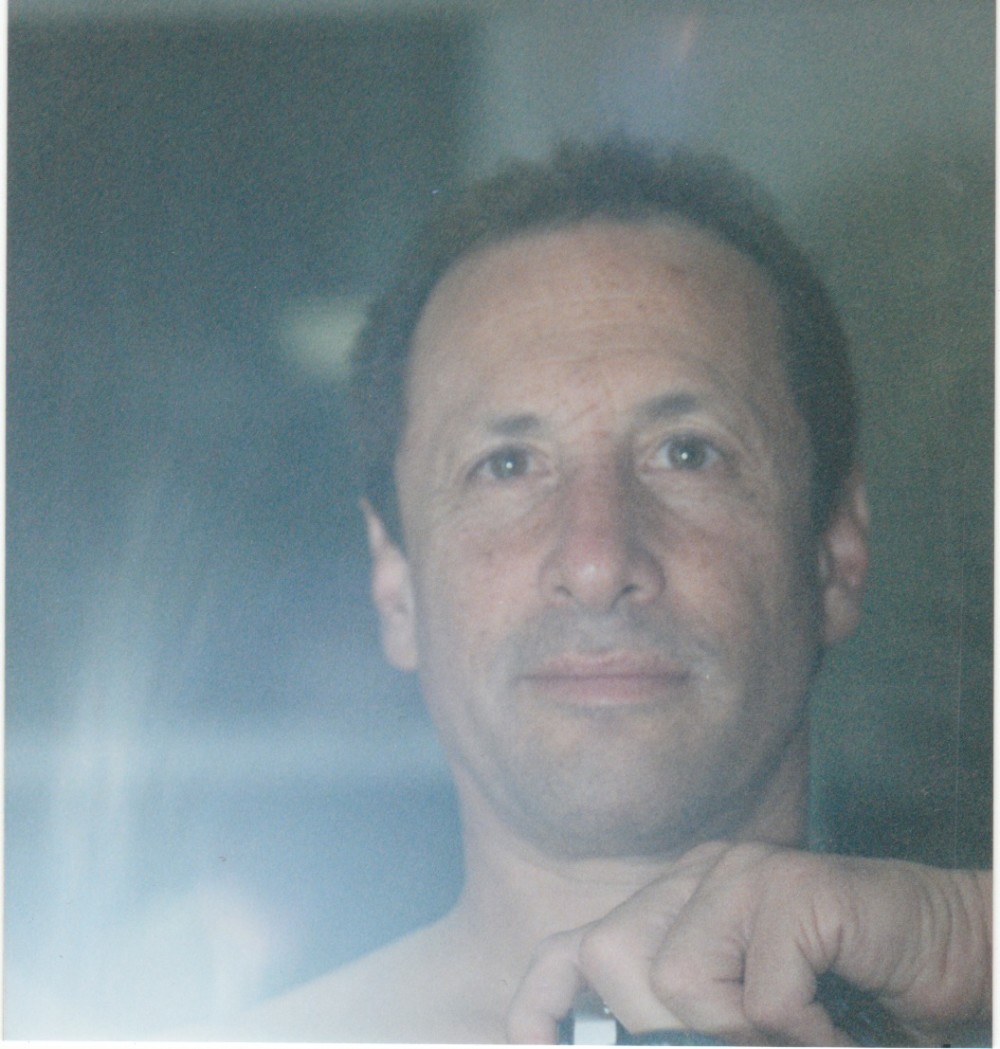The first week in rehab … someone tried to move Molly by grabbing her halo and using it as a handle. It was painful when the halo was moved like that. It was attached to Molly’s head by those 4 pointed screws, so if the halo moved at those points, it really hurt … and that happened a bunch of times during the 3 months Molly had to wear it. It was easy to bump in to. Above Molly’s bed, there was a bulletin board … and a message got written on it reminding everyone not to pull on the halo or the halo vest when moving her. People still forgot! Here’s a picture!  Notice the phone with the long attachment. Molly couldn’t move … so they set her up with a mechanism that she could puff and blow on … to answer and hang up the phone. Normally that attachment was down by her mouth during phone hours … so she could reach it. All of the non-movement … and the talk about permanent non-movement … was pretty upsetting for me. My best friend was lying there and it made me a little crazy … trying to figure out how I was going to get through it all.
Notice the phone with the long attachment. Molly couldn’t move … so they set her up with a mechanism that she could puff and blow on … to answer and hang up the phone. Normally that attachment was down by her mouth during phone hours … so she could reach it. All of the non-movement … and the talk about permanent non-movement … was pretty upsetting for me. My best friend was lying there and it made me a little crazy … trying to figure out how I was going to get through it all.
One day … Molly was being moved around by the nurses … and everyone lost their grip on her. She started to fall. A male nurse standing in front of her did a body block to stop her. He was successful in stopping her from hitting the floor … but in the process … he was stabbed by the blunt metal rods of the halo. After that, Molly had a friend bring in small round rubber balls to cover up the halo rods. It was much safer … and made the whole contraption softer looking … and less intimidating. Here’s what it ended up looking like. It became quite the conversation piece for visiting doctors and staff, and for all of the little kids who came around. Plus, when any of the balls disappeared and went missing … everyone … including the doctors … were on their hands and knees looking for the missing balls. 
Here is another picture that shows where the pointed screws went into Molly’s forehead.

Molly was in a single room now, and there was a door to the outside where there was an atrium that was beautifully landscaped … with lots of trees and plants. And … there were windows all along the wall of her room. They kept that door to the outside locked, but during the first week of getting to know Molly, when they began to realize that she was not the typical rehab patient … they unlocked the door and kept it open during the days. It provided Molly with a lot of fresh air and sunshine … and during the 6 weeks Molly was in rehab, I loved to cut thru the atrium to get to Molly’s room. I didn’t have to enter the hospital through the main door that way.
Molly was really missing music so she requested a CD/Tape player for her room. Music really lifted her spirits … and people brought in meditative and healing music for her to listen to, and to create a healing atmosphere in her room, which was getting filled up with plants … including several black bamboo containers. The hospital staff couldn’t believe it. After 3 days it was like a jungle in there … filled with all the plants and hearts and posters from everyone. I can’t believe I don’t have any pictures of that!
Then she wanted to laugh … because she hadn’t in a while. So she asked someone to bring her the film, Son In Law … with Pauley Shore … one of her favorite comedies … and she watched it and laughed for the first time in weeks. Molly said the laughter shook up all of the cells in her body … and engaged her diaphragm … which she was not able to do on her own. Then she wanted someone to bring her the film Resurrection … a movie with Ellen Burstyn about a healer who lived off the beaten path.
The movie inspired Molly to move beyond the idea of the prognosis that she had been given, and it gave her a sense of what was in store for her … and her own healing journey.
Because of Molly’s connection with Emily Conrad Dahoud, the founder of Continuum … and Emily’s work with quadriplegics at UCLA where people got function back that was previously unavailable to them … even after more than 10 years post injury … she knew she had some knowledge and information on spinal cord rehabilitation beyond the norm. She began to envision and prepare herself for the challenges she faced.
Dr. Inder Perkash was the head of spinal cord rehab at the VA Hospital in Palo Alto and Menlo Park. He had an assistant that was married to a friend of ours who was an Aikidoist, so he ended up hearing all about Molly … and he made a special trip to Stanford to meet her and to evaluate her condition during that first week in rehab. He was the top spinal cord injury doctor in our area … highly respected (he’s retired now) … an innovative and outside the box thinker … everyone got excited when he came to Stanford that day. He was like a rock star!
He spent quite a bit of time with Molly … watching … touching … and asking questions. He immediately asked that Molly’s bed be lined with sheepskin, as it allows the body to breathe … and it doesn’t rub the skin raw from being in one place when someone is immobile for long periods.
Dr. Perkash noticed that Molly had … what he called … “tone” in her legs. He could feel the energy in her legs, as well as in the rest of her body … and he was VERY positive about this … and liked what he saw. He was optimistic about Molly’s possibilities for rehabilitation … even though all of the other doctors we had seen were not. Then Dr. Perkash let everyone know that he knew Molly … and that he would be keeping an eye on her. The staff … who were already doing a great job … really perked up and looked after her in an even bigger way.
This was a welcome and positive jolt for Molly and I … the first one we had received since the whole thing began … and we both were elated from his positive feedback. It also validated Molly’s intuition about her possibilities.
Although Molly was now in rehab, it was still a few weeks before any rehab type activities would begin. Molly was still in a recuperating mode from all the trauma.
Even so, the nurses wanted to help Molly see if she could regain some control of her bladder … so they brought a bed pan … got it all set up … and then turned on the water in the bathroom sink. They thought that the sound of running water might stimulate Molly’s body memory. That idea didn’t work … but it was a good thought … and we really appreciated their supportive attitude to try it out, even though the doctor’s said it wasn’t possible to regain her bladder and bowel control. Months later, Molly proved them wrong.
In the middle of the week … a good friend of ours came to visit with Molly … and discovered that Molly still had weeds and other plant material and dried blood from the road and the accident … embedded in her scalp. It had been 3 weeks and even though Molly’s gorgeous long hair had all been cut for the surgeon … nobody ever cleaned her head … or washed her hair. So Jennifer asked the nurses to move Molly to a big chair and she rolled her over to the sink and washed her hair.
As for me … I was doing my best to assimilate all of the changes and negative predictions … stay calm … support Molly … and deal with everything that needed my attention.
I was still pretty confused by it all … and I had very little clarity about what any of it meant. I was nervous … and I was worried.
It was still quite early in the whole experience and I wasn’t sure how to make my peace with everything that had happened … or … how to accept it. I just wanted to be strong for Molly … myself … and our family.
Here is a 1995 selfie I took from that week. Molly thought I looked … slightly shell-shocked!
